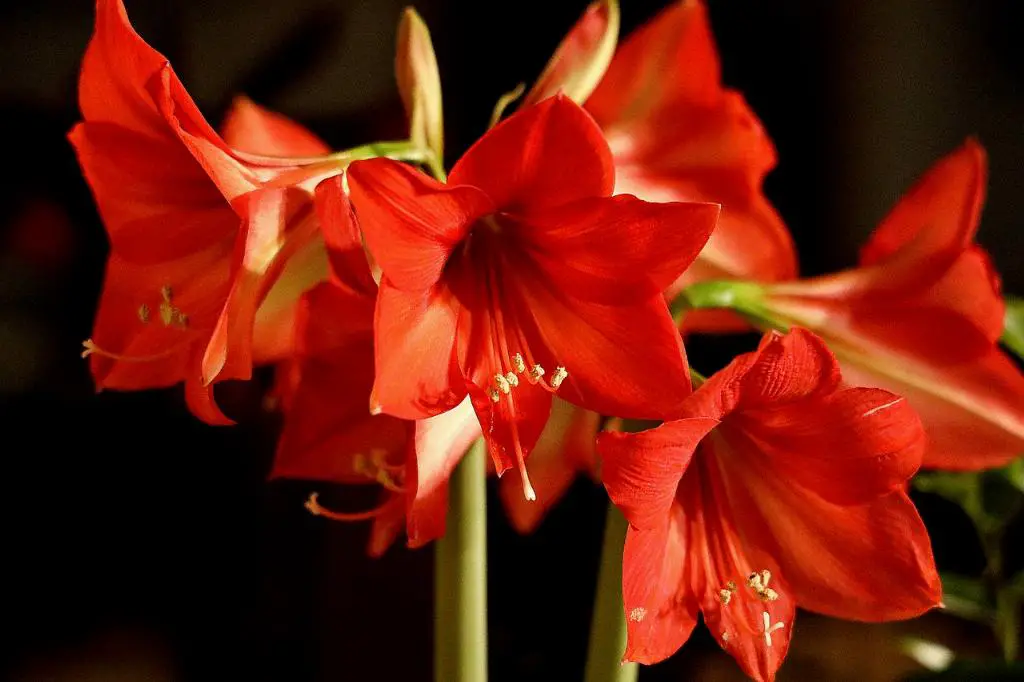The red amaryllis stands out in any garden or indoor setting with its bold blooms and regal stature. Known for its striking trumpet-shaped flowers, this beauty isn’t just another pretty face; it’s hardy, relatively easy to grow, and returns year after year with the right care. Often associated with the winter holidays, the red amaryllis symbolizes strength and determination due to its robust and upright growth. Whether you’re a seasoned gardener or a novice looking to bring some vibrant color indoors, understanding the allure and basics of red amaryllis can transform your approach to gardening.
Popular Varieties of Red Amaryllis
When you start exploring, you’ll find a breathtaking variety of red amaryllis. Each variety brings something unique to the table. ‘Red Lion’ is often praised for its deep, vibrant red flowers that can really make a statement in any room. On the other hand, ‘Ferrari’ is a true showstopper with its glossy, scarlet blooms that seem almost surreal in their perfection. If you prefer something a bit different, ‘Royal Velvet’ boasts luxurious, deep burgundy flowers that are almost mesmerizing. These varieties, among others, not only enhance your garden’s aesthetic but are also wonderful for cut floral arrangements, adding a touch of elegance and drama.
Ideal Growing Conditions for a Thriving Red Amaryllis
Getting the best from your red amaryllis starts with understanding its preferred growing conditions. Generally, these plants thrive in well-draining soil and a sunny spot, although they appreciate some afternoon shade in hotter climates. Indoors, a bright, sunny window is ideal. Temperature-wise, they prefer it warm but not hot, with ideal temperatures ranging from 68 to 70 degrees Fahrenheit during the day. When planting, ensure the top third of the bulb is above the soil, as this encourages a healthy growth cycle and prevents rot.
Step-by-Step Guide to Planting Red Amaryllis
Planting red amaryllis is a straightforward affair that guarantees stunning blooms if done correctly. Start by selecting a pot that is relatively snug around the bulb, as too much space can inhibit flowering. Fill the pot with a well-draining potting mix, plant the bulb with one-third exposed, and water it sparingly to start. Once the growth begins, increase watering, but always allow the soil to dry out between watering sessions to avoid waterlogging. Within six to ten weeks, you can expect to see those spectacular red blooms making their appearance.
Essential Care Tips for Red Amaryllis
Caring for red amaryllis is not labor-intensive but requires consistency. Water the plant regularly during the growth and blooming phase, letting the soil dry slightly between watering. Feed your amaryllis with a balanced, water-soluble fertilizer every few weeks to support its vigorous growth and blooming. After the amaryllis has bloomed, don’t rush to cut off the foliage as it needs to die back naturally to reabsorb nutrients. Store the bulb in a cool, dark place once the leaves have died back, and begin the cycle again for another season of stunning blooms.
Common Challenges and Solutions in Growing Red Amaryllis
While generally robust, red amaryllis can face a few challenges, such as bulb rot, fungal infections, and pest infestations. Overwatering is a common issue that leads to bulb rot; ensuring good drainage and a dry cycle between watering can largely mitigate this risk. For pests like aphids and spider mites, a gentle insecticidal soap or neem oil can be effective. If fungal problems arise, remove affected areas and treat with an appropriate fungicide, keeping in mind that prevention is always easier than cure.
Design Ideas: Decorating with Red Amaryllis
Red amaryllis can be more than just a garden plant; its vibrant blooms make it a perfect choice for festive decorations. Whether in a large pot by the fireside for a touch of Christmas cheer or as a centerpiece on the dining table, the bold red of the amaryllis adds a warm, inviting tone to any decor. For a rustic look, pair it with greens and wood textures. For something more elegant, a clear vase with pebbles and just a few tall, striking amaryllis stalks can create a sophisticated look.
The Symbolism and History of Red Amaryllis
The red amaryllis carries deep symbolism, often associated with strength and admirable beauty, making it a popular gift during the holiday season. Its origins trace back to the tropical regions of South America, where it was discovered in the early 18th century. The name ‘amaryllis’ comes from a shepherdess in Greek mythology, symbolizing pastoral beauty. This historical and symbolic background can add an extra layer of meaning to giving or displaying these magnificent flowers.
Where to Buy High-Quality Red Amaryllis Bulbs
For the best results, sourcing high-quality red amaryllis bulbs is crucial. Look for reputable nurseries or specialized online stores that offer a variety of amaryllis. Ensure that the bulbs are firm and dry with no visible signs of damage or rot. Bulb size can also be a good indication of quality, with larger bulbs often producing more stalks and flowers.
Red Amaryllis in Floral Arrangements and Bouquets
When it comes to floral arrangements, red amaryllis provides a dramatic height and vibrant color that can stand alone or enhance any bouquet. Its long stalk and minimal foliage allow it to blend seamlessly with other blooms, adding stature and focus. For a holiday bouquet, pair red amaryllis with greenery and gold accents for a festive feel. Or, for a year-round arrangement, mix with white lilies, blue irises, and some green foliage for a striking contrast that’s sure to captivate.

